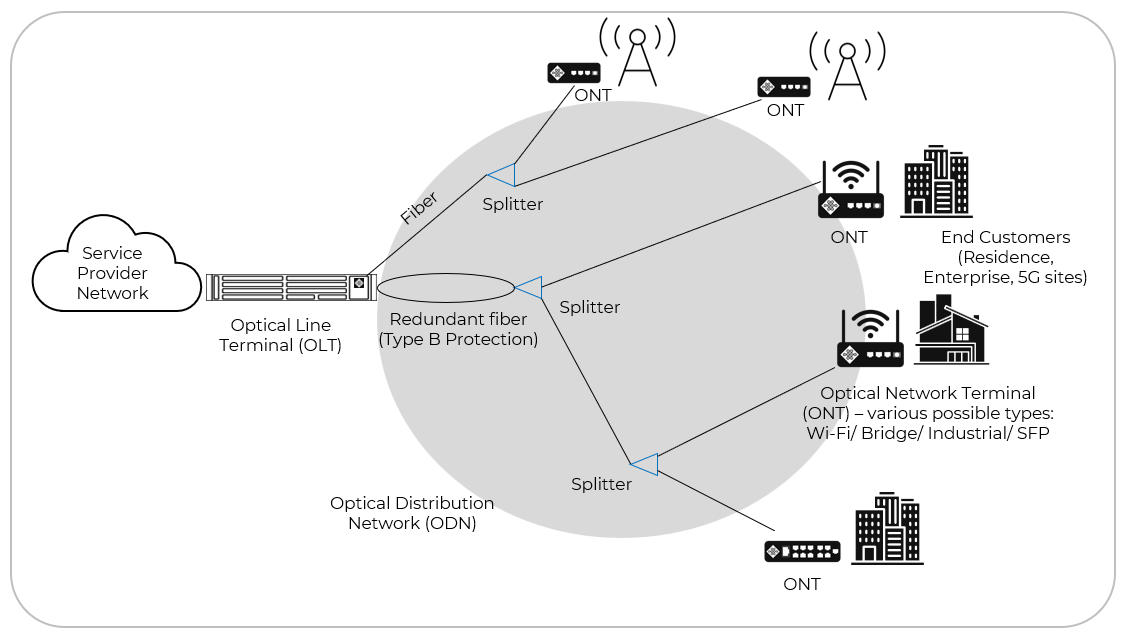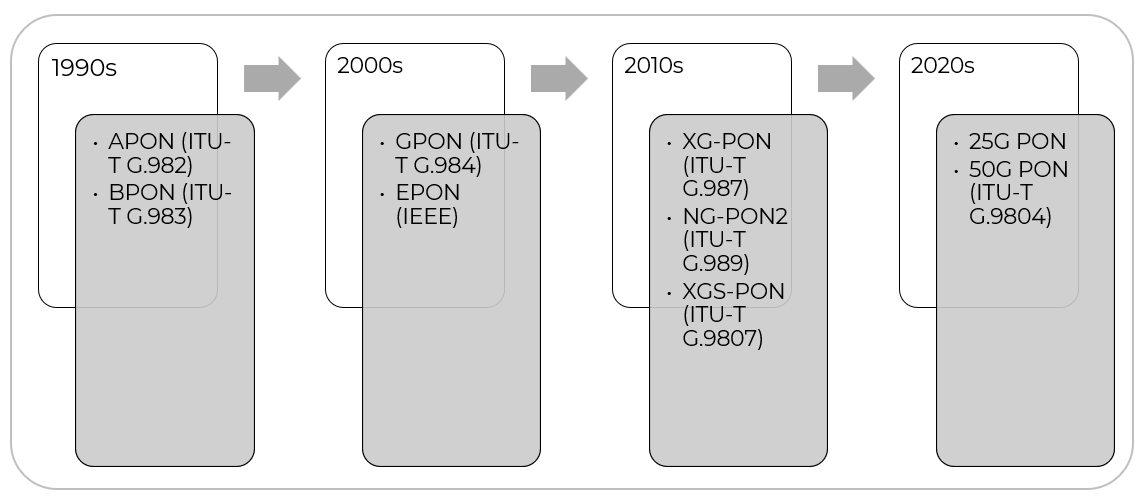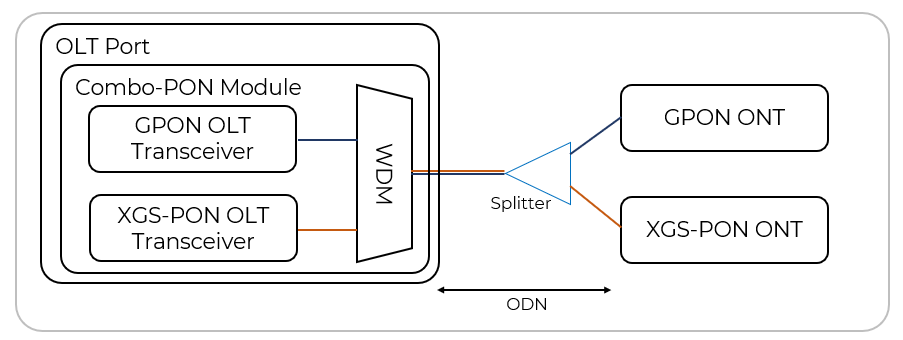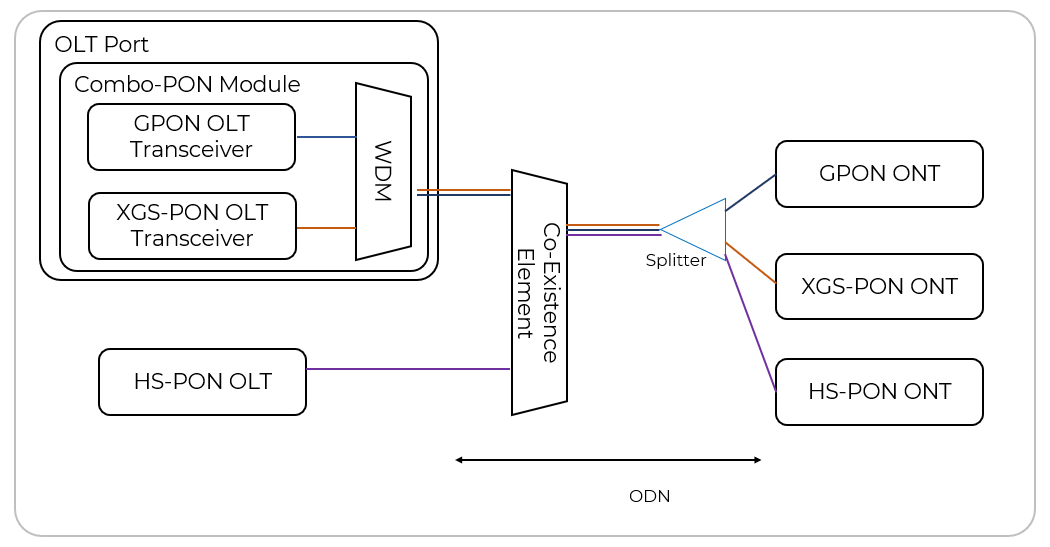- Blog
Navigating the Evolution of PON: The Road to 50G
In today’s hyper-connected world, the demand for faster, more reliable broadband is exploding—driven by immersive technologies like AR/VR, ultra-high-definition streaming, cloud computing, and smart enterprise applications. At the heart of this transformation lies Passive Optical Network (PON) technology, has become the backbone of modern fixed broadband infrastructure. Its ability to deliver high-speed, cost-effective, and scalable connectivity makes it indispensable for residential, enterprise, and mobile backhaul networks.
This blog explores the evolution of PON technology—from its early days to the cutting-edge 50G-PON and beyond —and how it’s evolving to meet tomorrow’s bandwidth demands. We’ll also dive into key concepts like coexistence between generations and strategic network evolution, helping stakeholders make informed decisions based on their current infrastructure and future goals.
Recap of the basics

Figure 1 – Passive Optical Networks
A Passive Optical Network (PON) is a fiber-optic communication system that connects a service provider’s network to multiple end-users using a point-to-multipoint architecture. At the heart of the network is the Optical Line Terminal (OLT), which sends and receives data over optical fiber. This signal is then distributed through a passive splitter, which divides the signal into multiple paths without requiring any power. The split ratio determines how many users can be served by a single OLT port Today it typically ranges from 1:8 to 1:128, with future possibilities of 1:256 or even higher. Each user has an Optical Network Terminal (ONT) or Optical Network Unit (ONU) at their premises, which converts the optical signal back into electrical form for use with devices like routers and set-top boxes. The entire physical infrastructure, including fibers, connectors, and splitters, is known as the Optical Distribution Network (ODN), and it plays a crucial role in ensuring reliable and high-speed data transmission across the network.
PON Technology Evolution

Figure 2 – Passive Optical Networks Technology Evolution
PON was first standardized by the ITU-T in the late 1990s as APON (ATM Passive Optical Network), which was primarily for ATM-based services. BPON evolved from APON and was standardized around 2001, adding support for broadband services like Ethernet and video. It provided 622 Mbps downstream, 155 Mbps upstream, which quickly became insufficient for growing internet demands. These standards utilized 1490 nm wavelength for downstream and 1310 nm for upstream.
GPON (Gigabit PON) was introduced in 2003, under the ITU-T G.984 series of recommendations. This standard marked a significant advancement over earlier generations, offering higher bandwidth: 2.5 Gbps downstream and 1.25 Gbps upstream. Multiple innovations supported these enhancements – such as more efficient encapsulation, improved optical transceivers, dynamic bandwidth allocation, better Forward Error Correction (FEC) etc. GPON supports higher split ratios(up to 1:128), enabling more users per OLT. Today, GPON is the dominant PON technology in many parts of the world in applications like residential connectivity and rural broadband. It uses the same 1490 nm wavelength for downstream and 1310 nm for upstream.
Following GPON, XG-PON (10 Gigabit-capable Passive Optical Network; here X = 10) was standardized by the ITU-T in 2010 under the G.987 series of recommendations. It provided 10 Gbps downstream and 2.5 Gbps upstream speeds.
XG-PON saw lesser commercial deployment compared to its successor, XGS-PON (10 Gigabit Symmetrical Passive Optical Network), which offers symmetric 10 Gbps speeds both in the downstream and upstream and became more widely adopted due to its simplicity and better alignment with modern broadband needs. It was standardized by the ITU-T in 2016 under the G.9807 recommendation. This has now become the natural successor of the GPON, and operators need to take this evolution into consideration in planning their deployment. In advanced markets, XGS-PON is already being deployed especially for enterprise networks, 5G xHaul, cloud services, and urban FTTx.
XGS-PON uses 1577 nm wavelength for downstream and 1270 nm wavelength for upstream, which are different from GPON’s wavelengths. This allows coexistence on the same fiber infrastructure, enabling gradual upgrades without service disruption.
Co-Existence of GPON and XGS-PON
Co-existence can be achieved in the following ways:

Figure 3 – Co-Existence with external element

Figure 4 – Co-Existence with help of Combo-PON (or Multi-PON)
Tejas PON platforms support Combo-PON SFPs which enables faster migration. Alternatively, deployment with external element is also feasible.
Beyond XGS-PON, when we look at emerging technology, there are 2 options: 25G PON and 50G PON.
25G PON is not standardized by ITU-T, but supported by an industry-driven MSA (Multi-Source Agreement) by some vendors and service providers. It was introduced around 2020 and supports 25 Gbps downstream and 10/25 Gbps upstream speeds.
50G PON (sometimes referred to as HS-PON i.e., High Speed PON) was standardized by ITU-T under G.9804 in 2021. It supports 50 Gbps downstream and 12.5/25/50 Gbps upstream speed.
50G PON uses 1340 – 1344 nm wavelength for downstream and multiple options for upstream: 1260 – 1280 nm/ 1290-1310 nm/ 1284 – 1288 nm.
There are some forecasting debates on 25G vs 50G technologies on which one will become dominant as the successor of XGS-PON or whether they’ll be complimentary. Tejas is also following ITU-T development very closely and developing 50G PON as the upcoming and long-term solution for evolving ultra-high bandwidth applications.
Co-Existence of 50G PON with previous generations
It can be understood from the above table that as long as the wavelengths are non-overlapping (option 3 in 50G US), all three generations can co-exist either with the help of a Co-Existence element or with Combo-PON capability. For some operators, depending on the equipment/ wavelength choice, they have to first migrate from GPON to XGS-PON for co-existence.

Figure 5 – Example of Co-Existence with help of Combo-PON and external Co-Existence element
Use cases for 50G PON
50G PON can enable a new set of use cases such as:
What may come after 50G PON?
The tech community has already started work on the next technology – 100G PON. Here, one option is 100G Coherent PON – unlike Intensity-Modulated Direct-Detection (IM-DD) systems used in GPON, XGS-PON, and even 50G-PON, coherent PON employs phase and amplitude modulation. Its use cases could span across high-capacity enterprise access, 6G mobile fronthaul/backhaul, edge cloud interconnects, and so on.
Strategic Network Evolution with Tejas Networks’ 50G-PON Ready Platform
Every telecom operator has a unique mix of customer segments, service requirements, financial models, and network evolution strategies. Among the most forward-thinking operators, we’ve observed a common approach: investing in the right technology at the right time—not too early to risk underutilization, and not too late to miss market opportunities. These operators also prioritize platforms that enable seamless technology upgrades without disruptive overhauls.
At Tejas Networks, our platforms are designed with this philosophy at their core. same chassis can support multiple generations of PON technologies simply by upgrading line cards.
We’re excited to introduce the TJ1400-7E, officially launching at India Mobile Congress 2025—a 50G-PON ready platform engineered for future scalability. This ultra-dense, modular 2RU system supports up to 64 GPON, 32 XGS-PON, or 32 Combo PON ports today, with a 50G-PON line card on the roadmap for 2026.
This means operators can fully leverage their existing GPON and XGS-PON deployments now, and seamlessly migrate to 50G-PON when market demand accelerates—ensuring long-term ROI and operational continuity.
References
This blog explores the evolution of PON technology—from its early days to the cutting-edge 50G-PON and beyond —and how it’s evolving to meet tomorrow’s bandwidth demands. We’ll also dive into key concepts like coexistence between generations and strategic network evolution, helping stakeholders make informed decisions based on their current infrastructure and future goals.
Recap of the basics

Figure 1 – Passive Optical Networks
A Passive Optical Network (PON) is a fiber-optic communication system that connects a service provider’s network to multiple end-users using a point-to-multipoint architecture. At the heart of the network is the Optical Line Terminal (OLT), which sends and receives data over optical fiber. This signal is then distributed through a passive splitter, which divides the signal into multiple paths without requiring any power. The split ratio determines how many users can be served by a single OLT port Today it typically ranges from 1:8 to 1:128, with future possibilities of 1:256 or even higher. Each user has an Optical Network Terminal (ONT) or Optical Network Unit (ONU) at their premises, which converts the optical signal back into electrical form for use with devices like routers and set-top boxes. The entire physical infrastructure, including fibers, connectors, and splitters, is known as the Optical Distribution Network (ODN), and it plays a crucial role in ensuring reliable and high-speed data transmission across the network.
PON Technology Evolution

Figure 2 – Passive Optical Networks Technology Evolution
PON was first standardized by the ITU-T in the late 1990s as APON (ATM Passive Optical Network), which was primarily for ATM-based services. BPON evolved from APON and was standardized around 2001, adding support for broadband services like Ethernet and video. It provided 622 Mbps downstream, 155 Mbps upstream, which quickly became insufficient for growing internet demands. These standards utilized 1490 nm wavelength for downstream and 1310 nm for upstream.
GPON (Gigabit PON) was introduced in 2003, under the ITU-T G.984 series of recommendations. This standard marked a significant advancement over earlier generations, offering higher bandwidth: 2.5 Gbps downstream and 1.25 Gbps upstream. Multiple innovations supported these enhancements – such as more efficient encapsulation, improved optical transceivers, dynamic bandwidth allocation, better Forward Error Correction (FEC) etc. GPON supports higher split ratios(up to 1:128), enabling more users per OLT. Today, GPON is the dominant PON technology in many parts of the world in applications like residential connectivity and rural broadband. It uses the same 1490 nm wavelength for downstream and 1310 nm for upstream.
Following GPON, XG-PON (10 Gigabit-capable Passive Optical Network; here X = 10) was standardized by the ITU-T in 2010 under the G.987 series of recommendations. It provided 10 Gbps downstream and 2.5 Gbps upstream speeds.
XG-PON saw lesser commercial deployment compared to its successor, XGS-PON (10 Gigabit Symmetrical Passive Optical Network), which offers symmetric 10 Gbps speeds both in the downstream and upstream and became more widely adopted due to its simplicity and better alignment with modern broadband needs. It was standardized by the ITU-T in 2016 under the G.9807 recommendation. This has now become the natural successor of the GPON, and operators need to take this evolution into consideration in planning their deployment. In advanced markets, XGS-PON is already being deployed especially for enterprise networks, 5G xHaul, cloud services, and urban FTTx.
XGS-PON uses 1577 nm wavelength for downstream and 1270 nm wavelength for upstream, which are different from GPON’s wavelengths. This allows coexistence on the same fiber infrastructure, enabling gradual upgrades without service disruption.
Co-Existence of GPON and XGS-PON
Co-existence can be achieved in the following ways:
- With the help of Coexistence Element:

Figure 3 – Co-Existence with external element
- Combo-PON Capability:

Figure 4 – Co-Existence with help of Combo-PON (or Multi-PON)
Tejas PON platforms support Combo-PON SFPs which enables faster migration. Alternatively, deployment with external element is also feasible.
Beyond XGS-PON, when we look at emerging technology, there are 2 options: 25G PON and 50G PON.
25G PON is not standardized by ITU-T, but supported by an industry-driven MSA (Multi-Source Agreement) by some vendors and service providers. It was introduced around 2020 and supports 25 Gbps downstream and 10/25 Gbps upstream speeds.
50G PON (sometimes referred to as HS-PON i.e., High Speed PON) was standardized by ITU-T under G.9804 in 2021. It supports 50 Gbps downstream and 12.5/25/50 Gbps upstream speed.
50G PON uses 1340 – 1344 nm wavelength for downstream and multiple options for upstream: 1260 – 1280 nm/ 1290-1310 nm/ 1284 – 1288 nm.
| GPON | XGS-PON | 50G PON | |
| Deployment status | Established technology | Deploying, strong traction for next few years | Early deployment, gradual momentum gain expected |
| Downstream speed | 2.5 Gbps | 10 Gbps | 50 Gbps |
| Upstream speed | 1.5 Gbps | 10 Gbps | 12.5/25/50 Gbps |
| Downstream wavelength | 1490 nm | 1577 nm | 1340 – 1344 nm |
| Upstream wavelength | 1310 nm | 1270 nm | Option 1: 1260 – 1280 nm/ Option 2: 1290 – 1310 nm/ Option 3: 1284 – 1288 nm |
There are some forecasting debates on 25G vs 50G technologies on which one will become dominant as the successor of XGS-PON or whether they’ll be complimentary. Tejas is also following ITU-T development very closely and developing 50G PON as the upcoming and long-term solution for evolving ultra-high bandwidth applications.
Co-Existence of 50G PON with previous generations
It can be understood from the above table that as long as the wavelengths are non-overlapping (option 3 in 50G US), all three generations can co-exist either with the help of a Co-Existence element or with Combo-PON capability. For some operators, depending on the equipment/ wavelength choice, they have to first migrate from GPON to XGS-PON for co-existence.

Figure 5 – Example of Co-Existence with help of Combo-PON and external Co-Existence element
Use cases for 50G PON
50G PON can enable a new set of use cases such as:
- Enterprise and Campus Connectivity: Supports multi-gigabit symmetrical bandwidth for cloud services and real-time collaboration, avoiding costly point-to-point fiber.
- 5G/6G Backhaul and Fronthaul: Meets high-capacity, low-latency needs for massive MIMO and network slicing in dense small cell deployments.
- Edge Cloud and Data Center Interconnects: Provides fast, low-latency links between edge nodes and data centers over shared infrastructure.
- High-Density Residential Areas: Handles growing demand for 4K/8K streaming, gaming, and AR/VR better than XGS-PON, with higher split ratios and bandwidth.
- Industrial IoT and Smart Cities: Delivers reliable, high-capacity connectivity for autonomous vehicles, smart grids, and real-time surveillance.
What may come after 50G PON?
The tech community has already started work on the next technology – 100G PON. Here, one option is 100G Coherent PON – unlike Intensity-Modulated Direct-Detection (IM-DD) systems used in GPON, XGS-PON, and even 50G-PON, coherent PON employs phase and amplitude modulation. Its use cases could span across high-capacity enterprise access, 6G mobile fronthaul/backhaul, edge cloud interconnects, and so on.
Strategic Network Evolution with Tejas Networks’ 50G-PON Ready Platform
Every telecom operator has a unique mix of customer segments, service requirements, financial models, and network evolution strategies. Among the most forward-thinking operators, we’ve observed a common approach: investing in the right technology at the right time—not too early to risk underutilization, and not too late to miss market opportunities. These operators also prioritize platforms that enable seamless technology upgrades without disruptive overhauls.
At Tejas Networks, our platforms are designed with this philosophy at their core. same chassis can support multiple generations of PON technologies simply by upgrading line cards.
We’re excited to introduce the TJ1400-7E, officially launching at India Mobile Congress 2025—a 50G-PON ready platform engineered for future scalability. This ultra-dense, modular 2RU system supports up to 64 GPON, 32 XGS-PON, or 32 Combo PON ports today, with a 50G-PON line card on the roadmap for 2026.
This means operators can fully leverage their existing GPON and XGS-PON deployments now, and seamlessly migrate to 50G-PON when market demand accelerates—ensuring long-term ROI and operational continuity.
References
- ITU-T G.9804.3 : 50-Gigabit-capable passive optical networks (50G-PON), https://www.itu.int/rec/T-REC-G.9804.3
- ITU-T G.9804.3 (2021) Amendment 1 (02/2023), https://www.itu.int/ITU-T/recommendations/rec.aspx?rec=15160&lang=en
- 50G-PON: Orange paves the way for the fiber of the future, https://hellofuture.orange.com/en/50g-pon-orange-paves-the-way-for-the-fiber-of-the-future/
- Coherent Passive Optical Networks 100 Gbps Single-Wavelength PON, Coherent PON architecture specification (CPON-SP-ARCH-I01-230503), https://account.cablelabs.com/server/alfresco/25300435-87c8-407d-9ab0-722287c7c7a6


